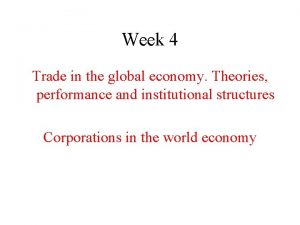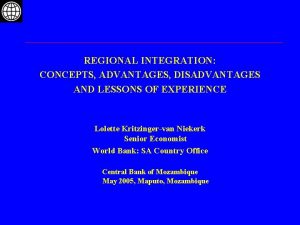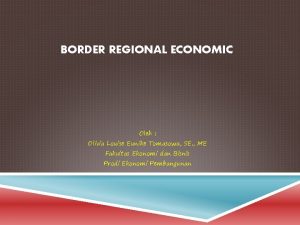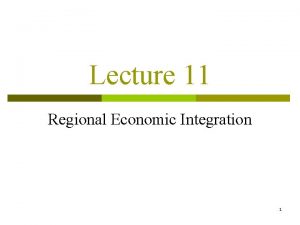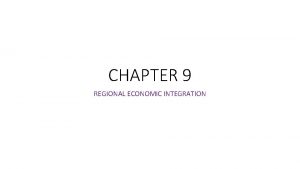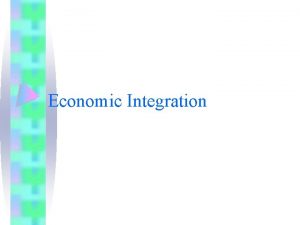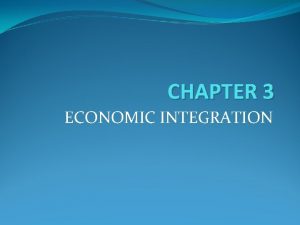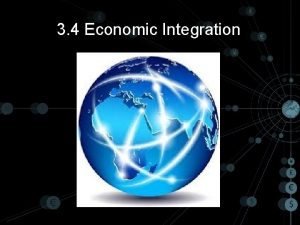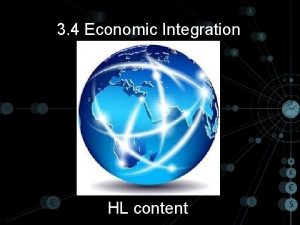Chapter 10 Regional Economic Integration Chapter 10 Regional









- Slides: 9

Chapter 10 Regional Economic Integration 经济学院 柳哲

Chapter 10 Regional Economic Integration 10. 1 The forms of economic integration 10. 1. 1 Preferential trade arrangements ----- provide lower barriers on trade among participating nations than on trade with nonmember nations. This is the loosest form of economic integration ASENA (1967)----- Association of South East Asian Nations Members: Indonesia, Malaysia , the Philippines, Singapore, and Thailand, Brunei, Vietnam 10. 1. 2 Free trade area ---- is the form of economic integration wherein all barriers are removed on trade among members, but each nation retains its own barriers to trade with nonmembers. NAFTA (1993) ----North American Free Trade Agreement Members: the United States, Canada, and Mexico

10. 1. 3 Customs union ---- allows no tariffs or other barriers on trade among members , and in addition it harmonizes trade policies (such as the setting of common tariff rates) toward the rest of the world. Benelux (1948)---- Belgium, the Netherlands, and Luxembourg 10. 1. 4 Common market ---- the free movement of goods and services among member nations; The initiation of common external trade restrictions against members; The free movement of factors of production across national borders within the economic bloc CACM (1960) --- Central American Common Market Members: Costa Rica, El Salvador, Guatemala, Honduras, and Nicaragua Economic union ----- goes still further by harmonizing or even unifying the monetary and fiscal policies of member states. This is the most advanced type of economic integration. EU (1958/1994)---- The European Union

10. 2 Trade-creating effect of customs unions 10. 2. 1 Trade creation ---- occurs when some domestic production of one customs-union member is replaced by another member’s lower-cost imports. Trade creation increases the welfare of member nations because it leads to greater specialization in production based on comparative advantage. 10. 2. 2 Illustration of a trade creating customs union A. USD 30 Tariff rate 100% B. USD 25 USD 20

Nation 2 In Nation 1 Px = $1 In Nation 3 Px = $1. 5 100% tariff rate of import commodity X Nation 2 import from Nation 1 = 50 x – 20 x = 30 x If Nation 2 now forms a customs union with Nation 1 Nation 2 import from Nation 1 = 70 x – 10 x = 60 x The area AGJC represents a transfer from domestic producers to domestic consumers, Net static gains to Nation 2 as a whole equal to $15 ---- the areas of shaded triangles CJM + BHN

10. 3 Trade-Diverting Customs Unions 10. 3. 1 Trade diversion ---- Occurs when lower-cost imports from outside the union are replaced by higher-cost imports from another union member. Trade-diverting customs union results in both trade creation and trade diversion, therefore can increase or reduce the welfare of union members. 10. 3. 2 Illustration of a Trade-Diverting Customs Union A $35 40% B $26 x C $20

Nation 2 S 1 and S 3 are the free trade perfectly elastic supply curves of X of Nation 1 and Nation 3 With 100% tariff Nation 2 import from Nation 1 = 50 x – 20 x = 30 X Forming a customs union with Nation 3 only; Nation 2 import from Nation 3 = 45 x The welfare gain in Nation 2 from pure trade creation is $3. 75 ----- the sum of the areas of the shaded triangles. The welfare loss from trade diversion is

10. 4 Dynamic benefits from customs unions 10. 4. 1 Increased competition. 10. 4. 2 Economies of scale 10. 4. 3 Stimulus to investment. 10. 4. 4 Better utilization of the economic resources of the entire community.

 What is regionalization
What is regionalization Advantages and disadvantages of regional integration
Advantages and disadvantages of regional integration Regional border
Regional border Three dimensions of corporate strategy
Three dimensions of corporate strategy Horizontal integration
Horizontal integration Simultaneous integration and sequential integration
Simultaneous integration and sequential integration Types of economic integration pdf
Types of economic integration pdf Economic growth vs economic development
Economic growth vs economic development Economic development vs economic growth
Economic development vs economic growth Economics unit 1 lesson 2 difficult choices
Economics unit 1 lesson 2 difficult choices
